Haemocytic Neoplasia of Mussels
On this page
Category
Category 2 (In Canada and of Regional Concern)
Common, generally accepted names of the organism or disease agent
Haemocytic, Haematopoietic or Haemic neoplasia, HCN, Disseminated neoplasia.
Scientific name or taxonomic affiliation
Unknown but may result from several causes representing a complex of diseases; possibly retrovirus-related in some cases on the west coast of North America and Europe. Most neoplastic haemocytic cells in Mytilus trossulus are tetraploid or pentaploid (Moore et al. 1991). Because the progenitor cell type has not been firmly established, the more conservative name of disseminating neoplasia is probably more appropriate for this disease.
Geographic distribution
U.K., Scandinavia, eastern and western North America including Canada.
Host species
Mytilus edulis, Mytilus trossulus and Mytilus galloprovincialis; oysters, and clams are also affected but a different aetiology may be involved.
Impact on the host
Neoplastic haemocytes (prolifreative mussel cells) appear in circulation and progressively replace normal haemocytes and normal physiological processes. Prevalence of this disease is usually less than 4% in mussels from Europe and the east coast of North America. However, prevalences can exceed 40% in some localities on the west coast of North America. In M. trossulus from Puget Sound, Washington, USA and British Columbia, Canada, haemocytic neoplasia can be transmitted by cohabitation, is progressive, impairs defense mechanisms, and is lethal. Annual cumulative mortalities often exceed 75% in mussels over 4 cm in shell length. However, remission was observed in 10-20% of the mussels examined. Although, haemocytic neoplasia may play a role in the high mortalities, the mussel stocks in this area may be short lived (in comparison to some stocks/species of mussels on the east coast of Canada) and may have a life cycle where reproduction is followed by senescence and death. In these mussels, haemocytic neoplasia may be one of the many consequences of senescence. Supporting this view are the facts that there is no shortage of small mussels and mussel recruitment is high, despite the common occurrence of haemocytic neoplasia and high mortalities between 12 and 24 months of age. Other stocks and/or species of mussels seem to be resistant to the west coast type of haemocytic neoplasia (Brooks 1991). The suggestion of Rasmussen (1986) that these neoplasias may be virus-related has yet to be proven.
Diagnostic techniques
Smears
Haemolymph from the heart with numerous abnormal haemocytes as described under Histology.
Histology
Intense infiltration of abnormal haemocytes (with very little cytoplasm in relation to nucleoplasm and with enlarged and often pleomorphic nuclei) and the presence of obvious mitotic figures. Mass proliferation of haemocytes may result in diapedesis of large clumps of cells and/or vascular occlusion in the most severe cases.
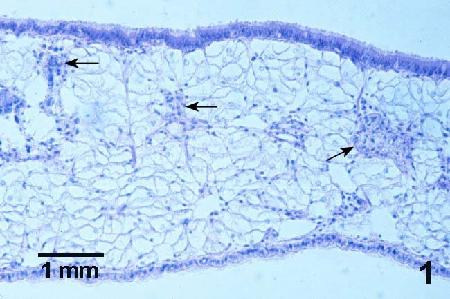
Figure 1. Histological section through the mantle of a normal juvenile mussel (presumably Mytilus trossulus). The undeveloped gonadal tissue (arrows) is surrounded by vesicular connective tissue cells. Haematoxylin and eosin stain.
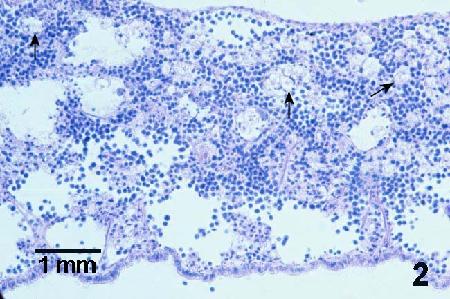
Figure 2. Histological section through the mantle of a juvenile mussel (presumably Mytilus trossulus) in an advanced stage of haemocytic neoplasia. The normal architecture of the connective tissue is disrupted, very little intact vesicular connective tissue (arrows) remains, and the tissue is heavily invaded by abnormal haemocytes (evident at this low magnification by their enlarged basophilic nucleus). Haematoxylin and eosin stain.
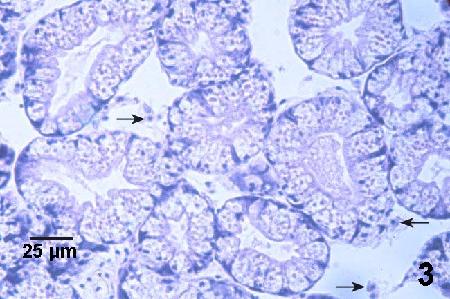
Figure 3. Histological section through the digestive gland of a normal mussel (presumably Mytilus trossulus). Note the presence of only a few normal haemocytes (arrows) in the spaces between the tubules. Haematoxylin and eosin stain.
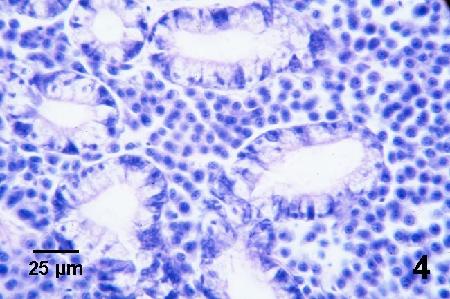
Figure 4. Histological section through the digestive gland of a juvenile mussel (presumably Mytilus trossulus) in an advanced stage of haemocytic neoplasia. An abundance of abnormal haemocytes, each with an enlarged nucleus containing two or more nucleoli and surrounded by a small amount of peripheral cytoplasm, occurs in the spaces between the tubules. Haematoxylin and eosin stain.
Histocytology (Haemocytology)
Examine haemocytes for characteristics described under Histology. The diseased haemocytes round up and lack pseudopodial adhesion to the slide.
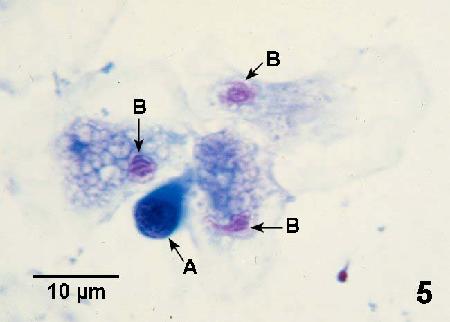
Figure 5. Haemocytes, from a mussel (presumably Mytilus trossulus) with an early stage of haemocytic neoplasia, in a histocytology preparation. An abnormal haemocyte (A) with an enlarged nucleus and very little cytoplasm is located near three normal haemocytes with eosinophilic nuclei (B) and cytoplasm spread thinly on the surface of the glass slide. Wright-Giemsa stain.
Immunological Assay
Monoclonal antibodies generated against neoplastic haemocytes of mussels from Puget Sound, Washington, USA did not react with normal cells and were proposed as suitable for immunoassays for diagnosis and quantification of haemocytic neoplasia in mussels (Noël et al. 1991).
Methods of control
No known methods of prevention or control. Due to the clearly demonstrated contagious nature of haemocytic neoplasia, every effort should be taken to avoid introducing infected stock (currently or historically). To date, the possibility of cross-transmission (between species of bivalves) has not been clearly demonstrated. The effect of the disease can be reduced by maintaining cultivated populations at as low a density as practical; harvesting prior to the typical period of increased mortality (autumn and winter) and harvesting stocks as young as possible (since the severity of infection appears to increase with age).
References
Barber, B.J. 2004. Neoplastic diseases of commercially important marine bivalves. Aquatic Living Resources 17: 449-466.
Bower, S.M. 1989. The summer mortality syndrome and haemocytic neoplasia in blue mussels (Mytilus edulis) from British Columbia. Canadian Technical Report of Fisheries and Aquatic Sciences 1703: 1-65.
Brooks, K.M. 1991. The genetics and epizootiology of hemic neoplasia in Mytilus edulis. Ph.D. Thesis, School of Fisheries, University of Washington, Seattle, Washington, USA.
Cosson-Mannevy, M.A., C.S. Wong and W.J. Cretney. 1984. Putative neoplastic disorders in mussels (Mytilus edulis) from southern Vancouver Island waters, British Columbia. Journal of Invertebrate Pathology 44: 151-160.
Elston, R.A., M.L. Kent and A.S. Drum. 1988a. Progression, lethality and remission of hemic neoplasia in the bay mussel, Mytilus edulis. Diseases of Aquatic Organisms 4: 135-142.
Elston, R.A., M.L. Kent and A.S. Drum. 1988b. Transmission of hemic neoplasia in the bay mussel, Mytilus edulis, using whole cells and cell homogenate. Developmental and Comparative Immunology 12: 719-727.
Elston, R.A., J.D. Moore and K. Brooks. 1992. Disseminated neoplasia of bivalve molluscs. Reviews in Aquatic Sciences 6: 405-466.
Farley, C.A. 1976. Proliferative disorders in bivalve molluska. Marine Fisheries Review 38(10): 30-33.
Gee, A., J.M. Specht, D. Kerk, J.D. Moore, A.S. Drum and R.A. Elston. 1994. Disseminated neoplastic cells in Mytilus trossulus: verification of host species origin by (16S-like) rRNA sequence comparison. Molecular Marine Biology and Biotechnology 3: 7-12.
Green, M. and D.J. Alderman. 1983. Neoplasia in Mytilus edulis L. from United Kingdom waters. Aquaculture 30: 1-10.
Kent, M.L., R.A. Elston, M.T. Wilkinson and A.S. Drum. 1989. Impaired defense mechanisms in bay mussels, Mytilus edulis, with hemic neoplasia. Journal of Invertebrate Pathology 53: 378-386.
Moore, J.D., R.A. Elston, A.S. Drum and M.T. Wilkinson. 1991. Alternate pathogenesis of systemic neoplasia in the bivalve mollusc Mytilus. Journal of Invertebrate Pathology 58: 231-243.
Noël, D., V. Boulo, D. Chagot, E. Mialhe, F. Paolucci, C. Clavies, E. Hervaud and R. Elston. 1991. Preparation and characterization of monoclonal antibodies against neoplastic hemocytes of Mytilus edulis (Bivalvia). Diseases of Aquatic Organisms 10: 51-58.
Peters, E.C. 1988. Recent Investigations on the disseminated sarcomas of marine bivalve molluscs. American Fisheries Society Special Publication 18: 74-92.
Rasmussen, L.P.D. 1986. Occurrence, prevalence and seasonality of neoplasia in the marine mussel Mytilus edulis from three sites in Denmark. Marine Biology 92: 59-64.
Citation Information
Bower, S.M. (2006): Synopsis of Infectious Diseases and Parasites of Commercially Exploited Shellfish: Haemocytic Neoplasia of Mussels.
Date last revised: December 2006
Comments to Susan Bower
- Date modified: